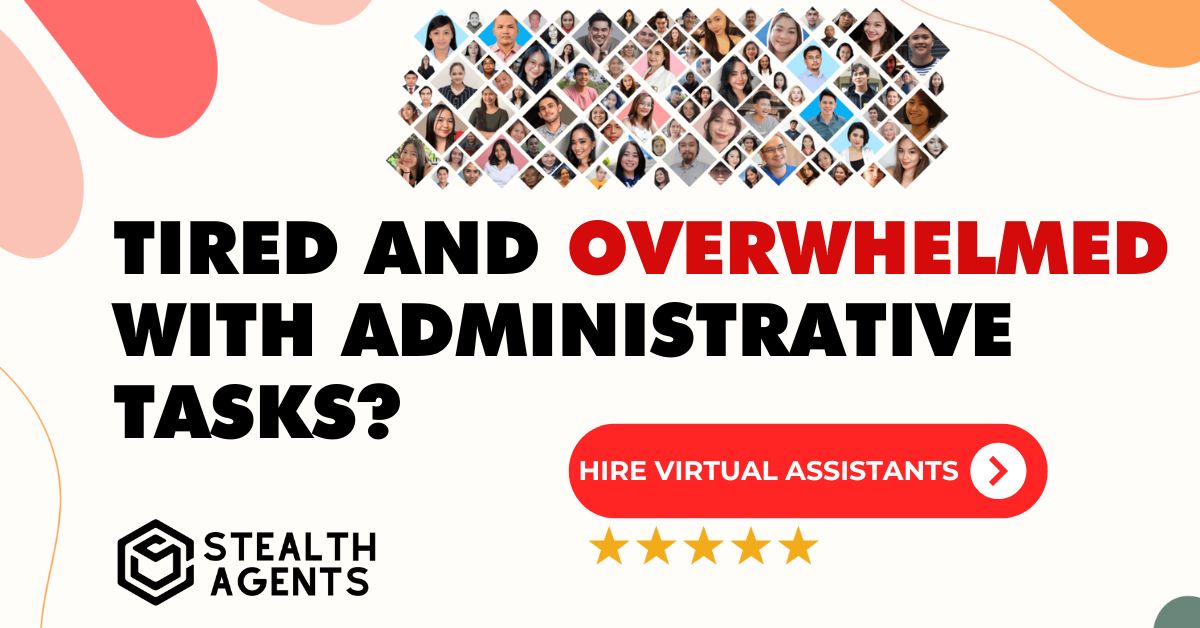Many businesses are turning to outsourcing as a cost-effective way to improve efficiency and expand their operations.
But with so many different options available, it can be overwhelming to navigate the world of outsourcing.
That’s where we come in! We’ve compiled a list of 50 outsourcing models that are commonly used in business, and we’ll break them down for you in simple terms.
Whether you’re a small startup or a large corporation, there’s an outsourcing model that can help your business grow.
Optimize your business challenges with an offshore virtual assistant business plan with Stealth Agents.
Book today and discover our budget-friendly fees.
Outsourcing Models in Business Terms
-
Outsourcing: Contracting out a business process or service to a third-party provider.
-
Offshoring: Outsourcing business processes or services to a company in another country.
-
Nearshoring: Outsourcing business processes or services to a company in a nearby country.
-
Onshoring: Outsourcing services to a company within the same country.
-
Business Process Outsourcing (BPO): Contracting a specific business task, such as payroll, to a third-party service provider.
-
Information Technology Outsourcing (ITO): Outsourcing IT-related tasks, such as programming or IT management, to a third-party provider.
-
Knowledge Process Outsourcing (KPO): Outsourcing knowledge-based and information-related business activities.
-
Legal Process Outsourcing (LPO): Outsourcing legal processes to an external firm or legal support services provider.
-
Recruitment Process Outsourcing (RPO): Delegating the recruitment process to an external service provider.
-
Manufacturing Outsourcing: Contracting out manufacturing processes to a third-party.
-
Cloud Outsourcing: Using cloud services for various business functions and processes.
-
Managed Services: Outsourcing daily management responsibilities and functions as a strategic method for improving operations.
-
Project Outsourcing: Contracting a third-party provider to handle specific projects.
-
Professional Services Outsourcing (PSO): Outsourcing of specialized professional services.
-
Selective Outsourcing: Choosing specific components or functions of a business process for outsourcing.
-
Total Outsourcing: Contracting out entire business functions to an external provider.
-
Multisourcing: Using a range of suppliers and integrating their services to meet business needs.
-
Co-sourcing: Sharing control of a business process or function with an external provider.
-
Staff Augmentation: Temporarily hiring external personnel to supplement a company’s workforce.
-
Transition Outsourcing: Moving business processes or services from one vendor to another.
-
Global Delivery Model (GDM): Providing services through a combination of offshore, nearshore, and onshore resources.
-
Virtual Employee Outsourcing: Hiring remote workers or virtual employees for specific roles.
-
Insourcing: Reverting an outsourced service or function back in-house.
-
Out-tasking: Outsourcing specific tasks within a larger business process.
-
Offshore Software Development: Outsourcing software development to a provider in another country.
-
Back Office Outsourcing: Outsourcing administrative and support functions.
-
Front Office Outsourcing: Outsourcing customer-facing services like customer support and contact centers.
-
Time and Material Contract: Outsourcing model based on paying for time spent and materials used.
-
Fixed Price Contract: A contract where the service provider is paid a set amount for a specific scope of work.
-
Bundled Services: Combining multiple services from a provider into a single package.
-
Hosted Services: Outsourcing IT services that are hosted by the service provider.
-
Application Service Providers (ASP): Companies that provide software applications and software-related services over the internet.
-
Payroll Outsourcing: Contracting an external organization to handle all payroll-related activities.
-
Call Center Outsourcing: Delegating call center operations to an external service provider.
-
Outsourced Chief Financial Officer (CFO) Services: Hiring an external, part-time CFO to manage financial strategy, planning, and reporting.
-
Crowdsourcing: Using a large group of people, usually from the online community, to obtain needed services, ideas, or content.
-
Outsourced Customer Support: Contracting external agencies to handle customer support services.
-
Third-Party Logistics (3PL): Outsourcing elements of a company’s distribution and fulfillment services.
-
Outsourced Data Center: Using third-party facilities for data storage and management.
-
Build-Operate-Transfer (BOT): A contract that begins with the provider building a facility, operating it for a time, and then transferring ownership to the client.
-
Outsourced Human Resources: Delegating HR functions to an external provider.
-
Franchise Model: A type of licensing agreement where a business allows another operator to trade under their brand name.
-
Greenfield Outsourcing: Starting an outsourcing operation from scratch, typically in a new location.
-
Joint Venture: A business agreement in which parties agree to develop a new entity and new assets by contributing equity.
-
Turnkey Project: A type of project that is constructed so that it can be sold to any buyer as a completed product.
-
Outsourced R&D (Research and Development): Contracting external organizations to conduct R&D activities.
-
Value-Added Reselling: A company adding features or services to an existing product and then reselling it as an integrated product or complete “turn-key” solution.
-
Strategic Outsourcing: Using outsourcing to achieve strategic goals, such as accessing new markets or leveraging advanced technologies.
-
Outsourced IT Security: Delegating IT security management to external specialized firms.
-
Business Transformation Outsourcing (BTO): Outsourcing with the goal of completely transforming a company’s processes and performance.
Hey there! So we’ve talked about 50 outsourcing models in business terms and I hope you found it informative. To quickly recap, we covered a wide range of outsourcing options that businesses can consider, from offshoring to managed services to crowdsourcing.









